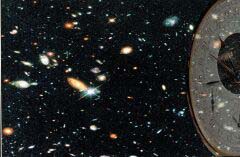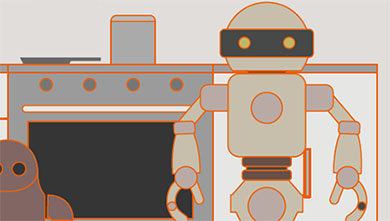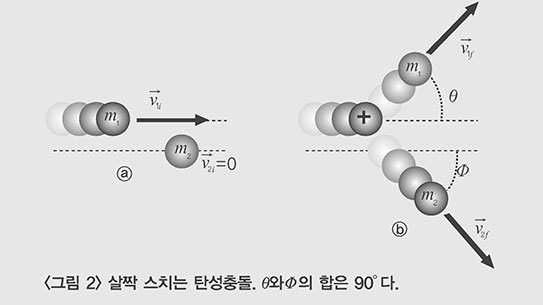호모 사피엔스의 두 주요 변종이 지구위에 있었고 1989년 12월에 이 둘이 유럽에서 한동안 공존했을지도 모름을 보여주는 증거가 드러났다.
첫번째 종류는 보통 '네안데르탈인'으로 알려져 있다. 이 변종의 최초의 뼈의 잔재가 서독 네안데르강의 계곡(독어로 탈)에 있었기 때문이다. 그 뼈는 분명히 사람의 것이었지만 특히 해골은 '현대인'과 재미있는 차이를 보여 주었다. 그것은 눈위에 두드러진 뼈의 등성이가 있었는데 현대인에는 없는 것이다. 그것은 또한 뒤로 기울어진 이마, 뒤로 처진 턱, 그리고 이상하게 튀어나온 이빨을 가졌다.
처음에는 그것이 정말 인간의 원시적인 종류인가, 뼈의 병을 앓은 여느 사람인가에 관해 상당한 논란이 있었다. 그러나 시간이 감에 따라 네안데르탈인의 다른 예들이 발견되었는데 그들 모두가 같은 뼈병을 가질 수는 없는 것이다.
더욱이 그들은 별로 원시적이지 않았다. 그들은 대체로 현대인들보다 키가 작았으나 단단하고 겉보기에 힘이 셌다. 그들의 뇌는 우리 것과 비슷하여 조금 크기도 했으나 비율이 달라 뒤에 더 많고 앞에 덜 있다.(당연히 우리는 뇌의 앞 부분이 '지식'을 만들고 중요하므로 우리가 네안데르탈인보다 우월하다고 가정한다. 그러나 그것을 뒷받침하는 진짜 증거는 없다.)
네안데르탈인은 정신적 동경을 가졌을 수도 있다. 적어도 그들은 죽은 사람을 꽃과 함께 묻은 증거가 있다. 대다수의 사람들은 네안데르탈인과 현대인이 호모사피엔스의 변종이라고 생각하는 것 같다. 전자는 호모 사피엔스 네안데르탈렌시스고 후자는 호모 사피엔스 사피엔스다.
1868년에 현대인의 초기 보기들이 프랑스 보르도 동쪽 약 1백20km에 있는 크로마뇽이라는 동굴에서 발견됐다. 이런 유적은 적어도 3만년은 된 것이다.
크로마뇽인들의 뼈에 살을 붙여 그릴때면 늘 수염을 깨끗이 깎고 (전혀 그럴 것 같지 않지만) 고상하고 어쩐지 슬픈 표정을 한 사람으로 보인다. 그들은 물론 백인으로 그려진다.
한편 네안데르탈인은 언제나 입술이 다물어지지 않고 얼굴이 지저분한 수염으로 덮여 있으며 얼빠진 듯한 눈을 가진 사람으로 그려진다.
프레드릭 마치가 출연한 영화 '지킬박사와 하이드씨'를 본 사람들은 지킬박사가 크로마뇽인의 살아 있는 화신이고 하이드씨는 네안데르탈인의 절대적인 이미지임을 주목할 것이다.
네안데르탈인은 현대인 이전에 있었다. 그는 분명히 10만년 전 유럽을 돌아다녔고 특히 원시적인 표본은 더 일찍 있었는지도 모른다. 그가 어디서 왔는지를 우리는 말할 수 없다. 그러나 모든 인류와 그 조상은 아프리카에서 기원했다는 강한 느낌이 있다.
우리는 네안데르탈인을 그들의 뼈뿐 아니라 그들이 남긴 도구를 통해서도 안다. 유럽에 널리 퍼진 것은 비교적 간단한 석기로 된 '무스티에문화'다 그것은 첫 보기들이 프랑스 무스티에의 모래 속에서 발견되었기 때문에 그렇게 불린다.
'오리냐크문화'의 도구도 발견된다. 이 이름은 이런 종류의 첫 유물이 프랑스의 오리냐크지방에서 발견된 데서 붙여졌다. 오리냐크문화는 현대인과 관련돼 있고 그 도구는 무스티에문화의 그것보다 훨씬 더 능숙하게 예술적으로 만들어졌다. 네안데르탈인과 현대인 사이의 차이점은 후자가 기술적으로 훨씬 더 발전했다는 것이 확실한 듯하다.
1878년에 스페인의 고고학자 마르셀리노데 사우투올라가 한 동굴의 천정에 그려진 그림을 발견했다(실제로는 그의 12살 난 딸이 그것을 처음 보았다.). 그것은 들소, 사슴, 그리고 다른 동물들의 그림이었고 2만년 쯤 된 것이었다. 이 옛날 미술가들은 그 이후의 어떤 미술가 만큼이나 솜씨있는 것이 명백했다. 비슷한 때 현대인은 활과 화살을 발명했는데 이것은 에너지가 천천히 저장되었다가 갑자기 풀려날 수 있는 장치였다. 그것은 위험한 동물들이 안전한 거리에서 공격될 수 있음을 뜻했다.
네안데르탈인이 멸종한 다음에(아프리카에서 나온) 현대인이 아시아로 이주했다가 동에서 서로 유럽을 휩쓸었다고 생각한 사람들이 있었다. 그러나 캘리포니아 멘로 파크에 있는 미국지질조사소의 제임즈 L. 비쇼프와 그의 스페인 동료들은 4만년이나 돼 보이는 오리냐크 유물을 발견했다.
그렇다면 현대인은 네안데르탈인과 충돌했을 것이고 무엇이 일어났을까 하는 의문이 나온다. 쉬운 답은 현대인의 우월한 기술이 네안데르탈인을 절멸했다는 것이지만 피가 섞였을 가능성도 있다. 그러나 오늘날 얻을 수 있는 증거로는 전혀 알 수가 없다.
Two chief varieties of Homo sapiens have existed on Earth, and in December 1989, evidence was unearthed to indicate that the two might have coexisted for a while in Europe.
The first variety is commonly konwn as "Neanderthal man" because the first bony remnants fo this variety were located in the vally("Thal") of the Neander River in western Germany. The bones were clearly human but the skull, in particular, showed interesting differences from "modern man." It had pronounced bony ridges above the eyes, which modern human beings don't have. It also had a backward-sloping forehead, a receding chin and unusually prominent teeth. There was considerable argument at first as to whether it was really a primitive kind of human being, or was an ordinary human being that suffered from some bone disease. However, as time went on, other examples of Neanderthal man were uncovered, and they couldn't all have had the same bone disease.
What's more, they weren't very primitive. They were, on the whole, shorter than modern man, but were stockier and apparently stronger. Their brains were as large as ours, even a bit larger, though they were differently proportioned, with more in the back and less in the front.(Naturally, we assume that the front part of the brain which gives us our "high brow" is more important so that we are superior to the "low brow" Neanderthals, but there is no real evidence of that.)
The Neanderthals may had spiritual yearnings. At least, there is evidence that they buried their dead and flowers. Most people seem to think that Neanderthal man and modern man are both varieties of Homo sapiens. The former is Homo sapiens neanderthalensis; the latter in Homo sapiens sapiens.
In 1868, early examples of modern man were found in a cave named Cro-Magnon, which is about 75 miles east of Bordeaux in France. Remains such as those are at least 30,000 years old.
When Cro-Magnon men are pictured, with flesh on the bones, they are always shown as clean-shaven(not at all likely) and with a noble and somewhat sad expression on their faces. They are white in coloring, of course.
Neanderthal man, on the other hand, is always shown with his lips hanging loosely, a dirty stubble all over his face and a vacant look in his eyes.
To those of you who have seen the motion picture "Dr. Jekyll and Mr. Hyde" starring Fredric March, you will notice that Dr. Jekyll is the living embodiment of Cro-Magnon man, and that Mr. Hyde is the absolute image of Neanderthal man.
Neanderthal man antedated modern man. He certainly roamed Europe 100,000 years ago, and particularly primitive specimens may have existed even earlier. Where he originated, we can't tell, but there is a strong suspicion that all human beings and their ancestors originated in Africa.
We know of Neanderthals not only by their bones, but by the tools they left behind. Widespread over Europe is the "Mousterian culture" consisting of comparatively simple stone tools. It is so called because the first examples were found in the sands of Moustier in France.
There are also tools to be found of the "Aurignacian culture," so called because the first relics of this kind were found in the town of Aurignac in France. The Aurignacian culture is associated with modern man, and the tools are much more skillfully and artfully made than are those of the Mousterian culture.l It seems certain that one difference between Neanderthal man and modern man is that the latter was far more advanced technologically.
In 1878, a Spanish archaeologist, Marcellino de Sautuola, discovered paintings on the ceiling of a cave. (Actually, his 12-year-old daughter saw them first.) They were paintings of bison, deer and other animals and were perhaps 20,000 years old. It was plain that these ancient artists were as skillful as any that have existed since. About the same time, modern man invented the bow and arrow, the first device in which energy could be slowly stored and then released all at once. It meant that dangerous animals could be attacked from a safe distance. Some people had thought the Neanderthals died out before modern man (originating in Africa)migrated to Asia and swept through Europe from east to west. However, James L.Bischoff of the U.S. Geological Survey in Menlo Park, Calif., and his Spanish colleagues have found Aurignacian materials that seem to be 40,000 years old.
If so, modern man collided with Neanderthal man, and the question is : What happened? The easy answer is that modern man's superior technology wiped out Neanderthal man, but there is also the possibility of interbreeding. With the evidence available today, we just don't know.
(C) 1990, Los Angeles Times Syndicate.
이 기사의 내용이 궁금하신가요?
기사 전문을 보시려면500(500원)이 필요합니다.
1990년 03월 과학동아 정보
🎓️ 진로 추천
- 역사·고고학
- 문화인류학
- 생명과학·생명공학

















